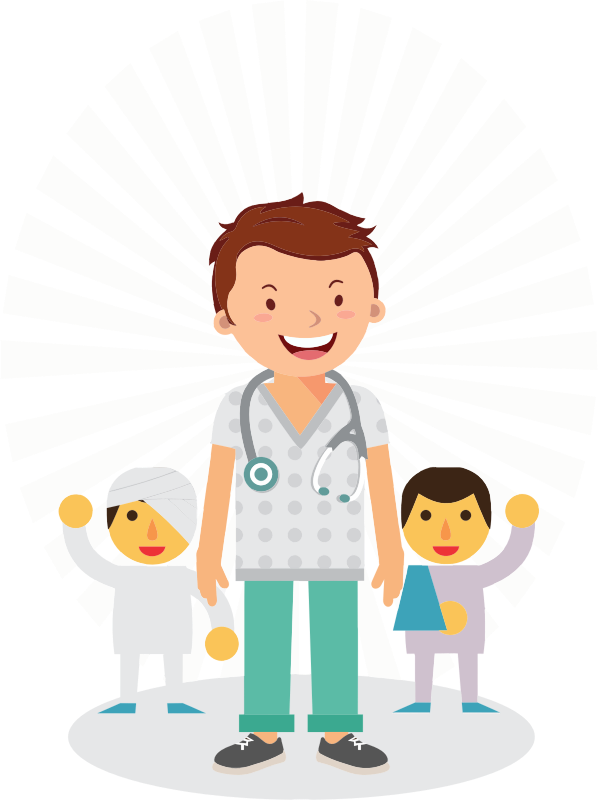Dramatic Play- Doctor's Office/ Hospital
Dramatic Play - Doctor's Office/ Hospital

A doctor with 2 young patients. One has a head bandage and his right eye is covered, The other has a broken left arm.
Clipart credit: www.openclipart.com
Description
The dramatic play center provides opportunities for students to collaborate, engage in learning, and build language skills through conversations. Children have the opportunity to role play real-life experiences by taking on many roles in imaginative play. Utilization of the space as a doctor's office/hospital encourages students to think like medical professionals, patients, and receptionists. It allows children to consider what is required to keep people healthy, and learn to recognize patient's feelings. It also encourages the child to think about scheduling appointments, medical tools, costs of medical care, to practice exchanging money. Children engage in taking turns with peers and developing vocabulary through interactions with one another.
Purpose
- fine motor skills while providing medical care to patients, such as performing routine checkups, bandaging sick patients, manipulating tweezers and toy syringes, and handling money
- math skills with the calculation of costs of procedures and appointments and exchange of money
- counting of materials and supplies needed to care for patients
- writing opportunities to write names of injuries and pretend prescriptions
- expression of artistic ability through the drawing of people
- print exposure to words about feelings, medical terms and charts, and pricing charts
- reading opportunities with exposure to a variety of books about medical experiences
- expression of feelings and emotions
- creativity, imagination, abstract thinking
- oral communication, vocabulary
- cooperation, sharing, taking turns
Suggested Materials
- stuffed animals and baby dolls
- bandages to use for attending to injuries
- toy medical equipment (stethoscope, thermometer, scalpel, syringe, medical cart, medicine bottles)
- cash register with play money
- pretend exam chairs
- medical charts and medical term reference charts
- labels on different pretend medicines or medical tools
- collect "drink koozies" to create casts for children arms (by removing the bottom to slide on arms)
- doctor jacket, or scrubs for patients
- telephone
- writing utensils
- paper, clipboards, notepads
- reading materials - medical related books in center, including nonfiction and fiction
Questioning Examples
These guiding questions can be used to assist the teacher, instructional assistant, or parent volunteers in supporting children's development and learning during play.
- Why did the person need to visit the doctor?
- What can you do to make sure the person gets better/healthy before leaving?
- What do you need to do to heal the sick patient?
- What type of doctor care instructions or prescription did you receive from the doctor?
- How did you heal the stuffed animals broken leg?
- How much money did you charge to see the doctor?
- How much did you have to pay to see the doctor?
Considerations
This center can be set up with the following: area to assess patients or exam seats, place for patients to sit and wait to be seen, and area for receptionist to sit with cash register and telephone . Provide an area to store labeled medical supplies( in boxes, baskets or containers). A basket/tote with books about medical related events should also be in the center for students to explore. In addition, supply writing prompt papers for customers to have the opportunity to chart medical procedures, create doctor care instructions and prescriptions, and record medical information (see attached prompt). Also, encourage children to try different roles of the doctor, nurse, patient, and receptionist .
This center should allow for enough space for at least three students to play with the furniture and props. The dramatic play center should be located in an area of the room that enables students to communicate without disrupting other children's work and play.
Photo Examples
Literature Connections
Many literature connections exist for this topic and can be read to students before introduction of the center or during learning of the theme of doctors office/hospital. These books can also be placed in the doctor's office/hospital center for independent exploration by the children. The following are a few suggestions:
"Biscuit visits the Doctor" by Alyssa Capucilli
"Inside Your Outside: All About the Human Body( with Cat in the Hat) by Tish Rabe
"I Want to Be A Doctor" by Laura Driscoll
"Curious George Goes to the Hospital" by H. A. Rey
"The Bernstein Bears Go To The Doctor" by Stan Bernstein
"My Doctor and Me ABC" by Dr. Stephanie Cox
"I Want to Be A Doctor" by Dan Liebman
"Little Critter: My Trip to the Hospital" by Mercer Mayer
Downloadable Resources
This is a center sign to be used at the Doctor's Office/Hospital
This is writing prompt for writing and illustrating doctor care instructions and patient complaint form.
Doctor Office Patient Information Sheet
Doctor Prescription/ Care Instructions
Clip art credit: www.openclipart.org